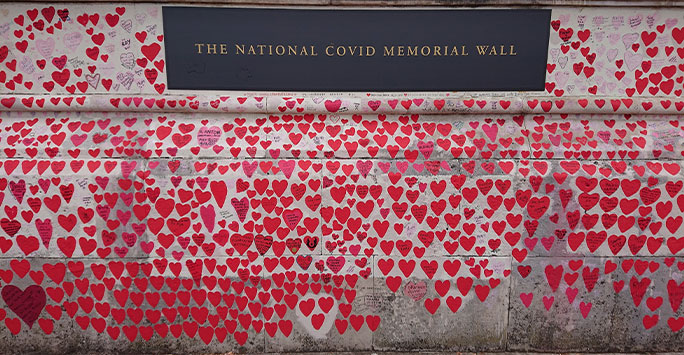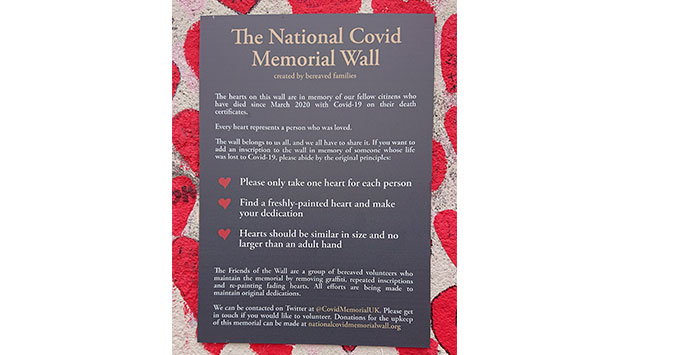
Two Liverpool students have just completed work worked on an Undergraduate Research Scheme project, led by Professor Anna Saunders, entitled ‘Covid-19 and the Memorial Landscape’. The project investigated the numerous different ways in which Covid-19 is being remembered in memorial form across the globe. Matthew Griffiths reflects here on his experience of the project and presents the central findings, while Xiaoyu Hua brings some of the key projects together into a vlog.
Despite the ongoing prevalence of Covid-19, there are a growing number of memorials to the pandemic, and those lost to it, across the world. This research project, which Xiaoyu and I carried out under the University of Liverpool’s Undergraduate Research Scheme, explored these means of remembrance and the trends of memorialisation that they represent.
The Covid memorials that we found included sculptures, woodlands, virtual archives and numerous other forms, each of which we have recorded in a database. This database will provide a platform from which to compare these memorials and establish the similarities and differences that exist in these projects across a wide range of cultures.
The research project was not without its challenges. Although there is plenty of readily available information on memorial projects across North and South America, Europe, much of East Asia and parts of Oceania, it was harder to find examples from some other regions. Most notably, whilst there have been a number of memorial projects in South Africa, it was difficult to find examples from across Africa, which was undoubtedly the hardest continent to research. Whilst it is possible to speculate whether this is the result of a lack of media coverage, or perhaps a genuine lack of memorials, this is an area that would benefit from further research to garner more definite answers.
This blog will focus on North America, South America and Europe, as, after dividing up the research, these were the regions that were my main focus during the project.

One thing that we have established is the prevalence of online Covid memorials. They Were Loved and CovidMemorial.Online both use images and links to social media to cultivate websites that serve as interactive memorials for victims of Covid in Canada and the United States respectively. Anyone can submit a picture of, and obituary for, a lost loved one, and this will then appear on an easily accessible website alongside many other pictures and obituaries. Whilst online memorials are not new, there appears to be a link between their increased prevalence and the nature of the pandemic, which required distancing, isolation, and thus greater reliance on the Internet. The trends within these online memorials have been explored by Faith Myers and Sarah Donley, whose research gives a solid overview of the growing online memorial landscape.
The natural world is another common theme across Covid memorials, and we found many examples of memorial gardens and woodlands. Italy’s Bergamo Wood of Memory, Madrid’s developing Forest of Lost Embraces and Chile’s planned memorial forest in Carén all place the same emphasis on nature. This creates memorials which will grow and change over time, serving both as symbols of remembrance and of regeneration. These projects create peaceful places for reflection, which will evolve to become much-loved green spaces in communities, benefitting mental health and the environment as well as memorial processes.
Sculptures may be seen as more conventional memorials, but there is still a vast range of designs, stories and messages behind them. One of the UK’s foremost examples is Reverence in Barnsley, a bronze sculpture depicting ordinary people who were affected by the pandemic in an attempt to represent us all. Whilst this is a relatively literal representation of people’s experiences, many more abstract sculptures exist. Rio de Janeiro’s Infinity Monument is a large, snake-like steel construction, with a place to sit and space for the engraving of 4,000 names. Whereas Barnsley’s sculpture is fairly self-explanatory, the abstract work in Rio presents greater scope for interpretation. Both sculptures are essentially commemorating the same thing, yet they go about it in completely different ways.
Other physical memorials encourage public involvement. Dutch memorials The Silence Column and Heart of Compassion, as well as the March of the Stones in Buenos Aires, all featured public engagement at some stage. The location of the Column was voted on by local Boxtel residents; anyone could place flowers on the Heart of Compassion, a large love heart in Amstelveen; and Argentine citizens participated in placing stones bearing messages to lost loved ones in front of the Casa Rosada government building. These physical memorials thus share an emphasis on public involvement with online memorials, which similarly require submissions in order to function.
Unique to physical memorials, however, is the importance of location. Many in urban environments are placed in prominent town squares or in close proximity to official buildings, with parks, cemeteries and hospitals also being popular places for memorial projects – the latter especially when the project is intended to commemorate the work and sacrifices of healthcare professionals.
Whilst most Covid memorials have similar or identical aims, there are some notable exceptions and complexities. Remembering those who lost their lives to Covid and commemorating healthcare workers are, naturally, the two most prominent functions of the memorials, but in some cases the intentions are more complex, split between memorialising and protesting. In March 2021, 25,000 white crosses were painted onto Prague’s old town square by the Million Moments for Democracy group, with the intention being to both commemorate the then-25,000 Czech victims of Covid and protest perceived government inaction in response to the pandemic. Similarly, London’s National Covid Memorial Wall, with a heart painted for every life lost to Covid in the UK, was initiated by Covid-19 Bereaved Families for Justice in conjunction with protest group Led By Donkeys, with both groups campaigning for a public inquiry into the government’s handling of the pandemic. The wall deliberately faces Parliament, again demonstrating the importance of location for physical memorials.
As Covid memorials become increasingly commonplace, it is worth contemplating their form, location and purpose, as well as their temporal proximity to what is an ongoing crisis. This blog is simply an overview, but one that I hope acts as an encouragement to explore and engage with this growing memorial landscape. There is already something of a public desire to remember, rather than to forget.